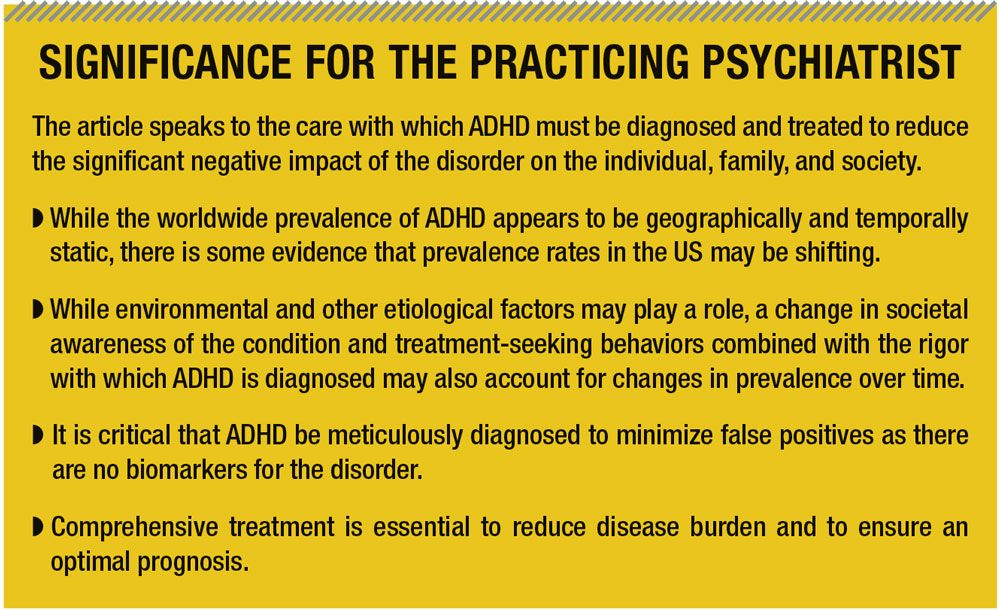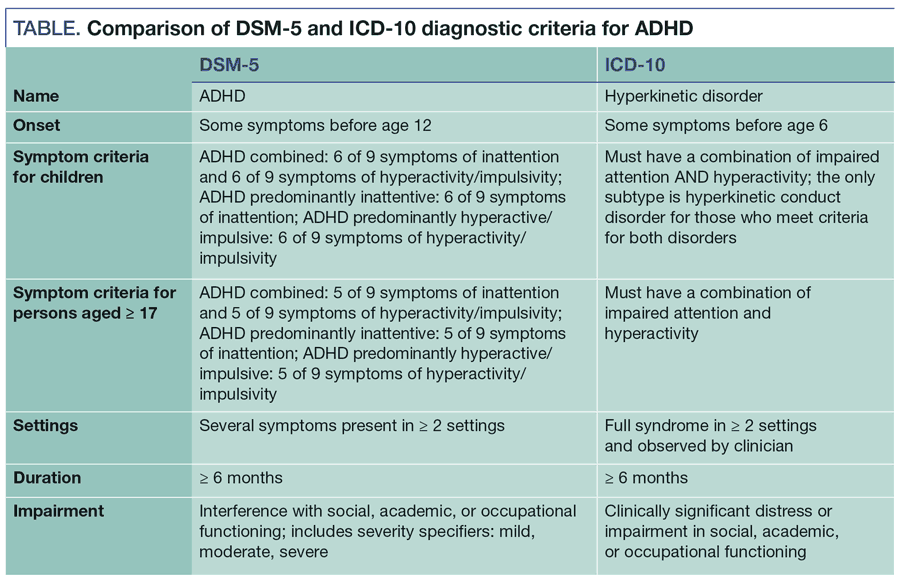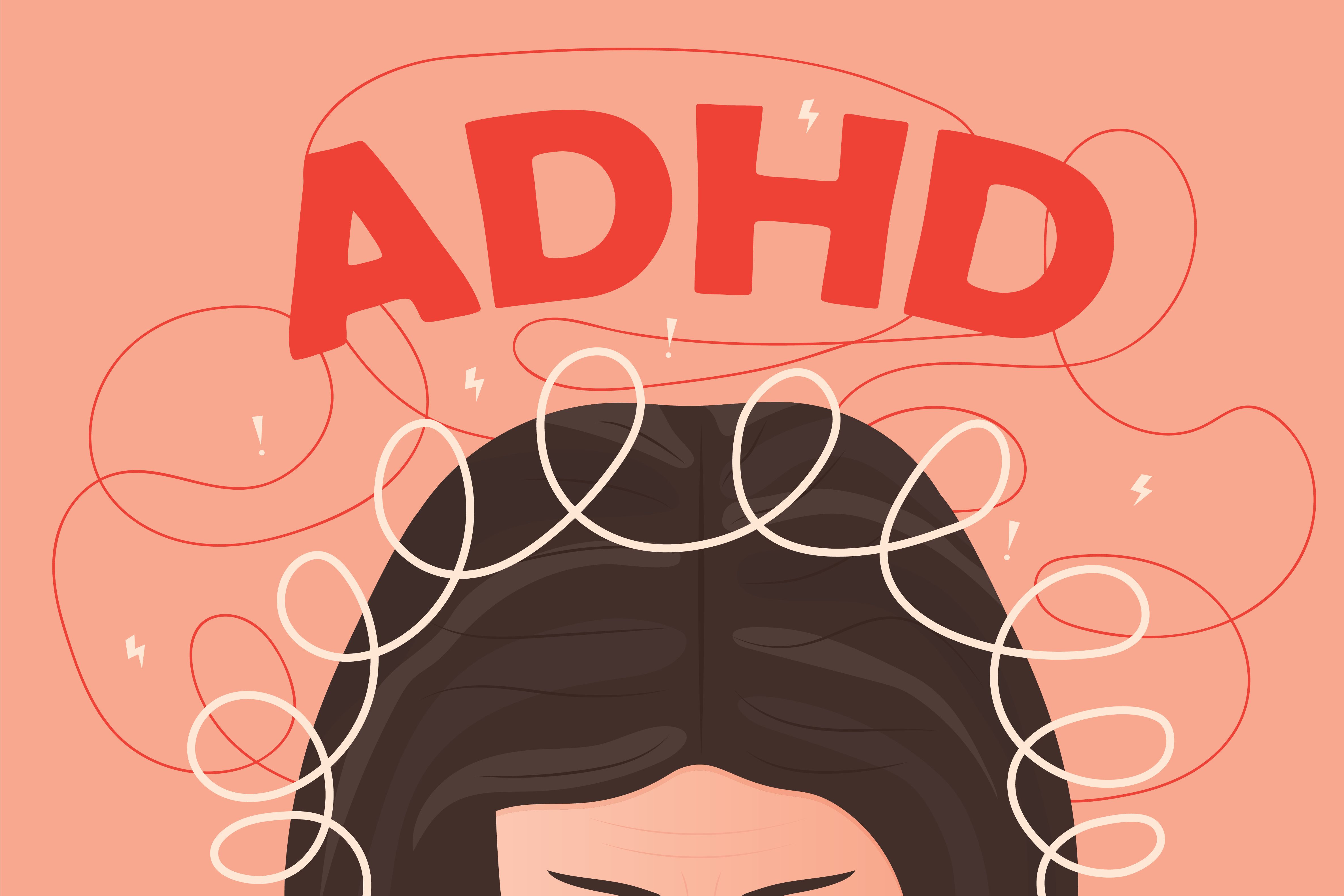Publication
Article
Psychiatric Times
Are We Overdiagnosing and Overtreating ADHD?
Author(s):
This article speaks to the care with which ADHD must be diagnosed and managed to reduce the significant negative impact of the disorder on the individual, family, and society.
SIGNIFICANCE FOR THE PRACTICING PSYCHIATRIST

TABLE. Comparison of DSM-5 and ICD-10 diagnostic criteria for ADHD

While the existence of ADHD continues to be debated in some circles, descriptions of the syndrome date back to the 18th century and its treatment to a report by Charles Bradley in 1935.1 It has since come to be widely recognized by many as the most common neurodevelopmental disorder of childhood. It is more likely to be diagnosed in boys and negatively affects academic and social achievement. Untreated, the condition takes a toll on a child’s self-esteem and self- confidence.
Comorbidity is the rule as ADHD often co-occurs with other symptoms and disorders, including tics, anxiety, mood dysregulation, disruptive behavior, and/or learning disabilities. Moreover, persons who have ADHD are at increased risk for a substance use disorder.
ADHD is a chronic condition that can last a lifetime. Approximately 50% of children with the disorder continue to experience debilitating symptoms into adulthood. While notable hyperactivity and impulsivity may abate, inattention and executive functioning deficits often persist. Adults with ADHD have markedly higher rates of divorce, unemployment, traffic violations, substance use, and arrest than their unaffected peers.
While ADHD clearly places a significant burden on the individual, family, and society at large, there has been debate regarding its diagnosis and treatment. Overdiagnosis is a concern as it may cause the medicalization of normal variants in the population and lead to unnecessary treatment interventions that may have little or no benefit and that pose unacceptable risks of adverse effects. Overtreatment not only burdens patients with adverse effects but misappropriates and overwhelms limited medical and other resources essential to the management of those with actual disease.
To address diagnostic and treatment concerns, it is critical to understand how ADHD is diagnosed. As with most, if not all, neuropsychiatric disorders, there is no established gold-standard or neuroimaging test to confirm the diagnosis of ADHD; nor are there well-established biomarkers-diagnosis and treatment are symptomatically rather than etiologically driven. Diagnosis therefore depends on phenomenology, subjective reports, and clinical observations of symptoms of the condition that lead to dysfunction.
Diagnosis
The contemporary diagnosis of ADHD based on DSM-5 criteria requires the presence of 6 or more inattentive symptoms and/or 6 or more symptoms of impulsivity and hyperactivity in children. The criteria for ADHD are slightly different for adults: those aged 17 years and older need only demonstrate 5 symptoms to meet the criteria. DSM-5 further stipulates that symptoms must be present in 2 or more environments, begin prior to age 12, cause notable dysfunction, and not occur primarily in the context of a psychotic illness or be better accounted for by another mental disorder or medical condition.
DSM-5 is not the only diagnostic nosology. While it is commonly used in the US, much of the world uses ICD-10. ICD-10 refers to ADHD as hyperkinetic disorder (HD), and the diagnosis requires the presence of symptoms of both overactivity and inattention, present before age 6. Given inconsistencies in diagnostic criteria for the condition worldwide and over time, one may expect discrepant estimates of its prevalence from one region to another and over the years.
The Tablesummarizes DSM and ICD diagnostic criteria.
Prevalence
In 2007, Polanczyk and colleagues2 completed the first comprehensive meta-analysis of the prevalence of ADHD among children and adolescents. They attempted to gauge the worldwide pooled prevalence of ADHD or HD by including 102 studies that consisted of 171,756 subjects 18 years and younger from around the globe and that used DSM or ICD criteria for diagnosis. They found the ADHD/HD worldwide pooled prevalence to be 5.29% based on significantly variable data.
In their analysis, the prevalence among studies varied primarily because of methodological differences, including diagnostic criteria used, sources of information, and adherence to the requirement that impairment be present to make a diagnosis. In fact, prevalence estimates based on DSM-IV were higher than those based on ICD-10. Interestingly, geographic origin played a limited role. Although prevalence estimates from Africa and the Middle East were lower than those from North America, there were no other significant geographic differences.
Erik Willcutt3 subsequently published a comprehensive meta-analysis to estimate the prevalence of ADHD based on criteria from DSM-IV. He included 86 studies of children and adolescents and 11 studies of adults. He also found wide variability in prevalence estimates between individual studies. He reported that the pooled prevalence estimate of ADHD was 5.9% to 7.1% for children and adolescents. This was the case whether ADHD was diagnosed through parent ratings on questionnaires, teacher ratings, or a best-estimate diagnostic procedure when full DSM-IV diagnostic criteria were applied. The pooled estimate in young adults was 5.0% and was based on self-report measures. When the methodology used to diagnose ADHD was controlled for, there were no significant differences in prevalence between countries or regions of the world.
In 2015, Thomas and colleagues4 published a meta-analysis that consisted of 175 eligible studies over a 36-year period worldwide. They demonstrated an overall pooled prevalence of 7.2% and found that prevalence estimates for ADHD were lower when DSM-IIIR was used, compared with DSM-IV, and when studies were conducted in Europe, compared with North America.
In 2015, Polanczyk and colleagues5 undertook a meta-analysis to determine the worldwide prevalence of various mental health disorders in children, including ADHD. Based on 41 studies conducted in 27 countries between 1985 and 2012, they found a pooled prevalence of ADHD of 3.4%. Notable variation among the studies was seen, which indicates that methodology, such as representativeness of samples and use of diagnostic interviews and impairment criteria, had a significant impact on heterogeneity rather than geographic location or year of data collection. In fact, no increase in the prevalence of ADHD over time was demonstrated.
Concern that changes in diagnostic criteria could affect accurate identification of ADHD led McKeown and colleagues6 to examine the effect of the change in diagnostic criteria from DSM-IV to DSM-5 based on parent and teacher reports of elementary school students in South Carolina and Oklahoma. Prevalence estimates based on DSM-5 criteria with an age of onset before age 12 were demonstrated to be higher than prevalence estimates based on DSM-IV criteria with an age of onset before age 7. Again, methodology affected prevalence estimates.
In the US, parent reports of clinician-diagnosed childhood ADHD have been collected through periodic national phone surveys, beginning in 1996. The most recent data were collected in 2007 to 2008 (2007) and 2011 to 2012 (2011) through the CDC’s National Survey of Children’s Health (NSCH), a cross-sectional parent survey of the physical and emotional health of children age 17 and younger.
Prevalence estimates in 2007 were higher than approximations in 2003. In 2007, 7.2% of school-aged children were estimated to have ADHD. Of those children, two-thirds were treated with medication-4.8% of US children age 4 to 17. Survey data in 2011 indicated a current national prevalence of 8.8%, and a lifetime prevalence of 11.1%, which reflects an increase in the diagnosis of the disorder. Of those diagnosed, 69% were treated with medication-6.1% of US children.
Children with untreated ADHD were described by their parents as having a moderate to severe condition. While there appears to have been an increase in diagnosis and treatment, prevalence estimates were found to remain the same or decrease in certain populations. In fact, between 2007 and 2011, prevalence estimates of ADHD remained static for older adolescents and decreased for children who were multiracial or of other races.7
Related content:
Slideshow on ADHD
Despite these important findings, it is noteworthy to put the NSCH data into perspective. The results are culled from a single question asked of a parent: whether he or she had ever been told by a health care provider that his or her child has ADHD. In addition, the NSCH data do not provide insight into the underlying reason for the decrease in diagnosis in some populations, nor do they indicate whether those who were not treated with medication received some other form of therapy.
Surveys that examine the prevalence of adult ADHD have mostly used pre-DSM-5 criteria and are generally based on self-report. The National Comorbidity Survey–Replication showed a current ADHD prevalence of 4.4 % among adults.8
Increasing prevalence
As these findings demonstrate, there seems to be a generally increasing prevalence of ADHD in the US. This upward trend may reflect better public education and awareness of the disorder. It is also possible that the increasing recognition of the inattentive subtype may be driving some of the changes in prevalence.
Etiological factors such as environmental pressures may be responsible for the rise in ADHD prevalence. Researchers have been exploring pollution, prematurity, and consumption of food additives among various other environmental insults as contributors to the pathophysiology of ADHD.9 No clear relationships have been established, and ongoing investigation is clearly indicated.
Another source of change in prevalence estimates may stem from methodological differences and differing criteria. However, there are also realistic concerns that the increasing prevalence of the disorder and its treatment may be artificial and reflect poor diagnostic practices and treatment that is increasingly reliant on medication. When child and adolescent psychiatrists are available to evaluate children, they are less likely to initiate medication management immediately upon diagnosing ADHD. But child and adolescent psychiatrists represent a small percentage of clinicians, and the vast majority of ADHD cases are identified and treated by primary care practitioners.
To examine how primary care practitioners approach the evaluation and treatment of ADHD, Epstein and colleagues10 conducted random reviews of 1594 patient charts from 188 pediatricians at 50 different practices. They discovered significant variability:
• Parent and teacher rating scales were used as part of the assessment in only about half of the cases
• DSM criteria were not universally documented
• 93.4% of patients with a diagnosis of ADHD were treated with medication
• Only 13% received any form of psychosocial intervention
Treatment
ADHD is a complex disorder that is not simply the sum of a checklist of symptoms. The consequences are far-reaching socially, emotionally, behaviorally, and occupationally. It is therefore essential that careful diagnostic procedures are implemented to identify true cases. Best practices in diagnosing ADHD are well established. Although rating scales are known to be sensitive, they lack specificity, leading to a high false-positive rate for the disorder. Rating scales must therefore be combined with a comprehensive assessment of patients, and in the case of children, their parents.
Obtaining information about symptoms in multiple environments with the use of multiple informants is critical. For example, it is good clinical practice to interview teachers and, at times, conduct observations in the classroom before making a diagnosis. Meticulous assessment for ADHD reduces misidentification of the condition when symptoms are the manifestation of another disorder, such as a mood, anxiety, substance use, learning, or disruptive behavior disorder. Conditions that frequently co-occur with ADHD must be a focus of treatment as well.
CDC surveys have shown that about 17.5% of children with ADHD are not being treated for the disorder. The Multimodal Treatment of Attention-Deficit/Hyperactivity Disorder (MTA) trial demonstrated the superiority of medication for the short-term management of ADHD symptoms.11 However, the long-term effects of treatment, such as therapeutic benefit and adverse effect burden, have been fiercely debated.
There is also rising concern about stimulant misuse, especially among adolescents and young adults, as evidence suggests that they may feign symptoms of ADHD to obtain stimulants for performance enhancement.12 It is therefore imperative to assess both current and historical symptoms and to clarify the degree of functional impairment. Careful monitoring of treatment and requests for prescriptions is critical.
Both the American Academy of Child and Adolescent Psychiatry and the American Academy of Pediatrics have published clinical guidelines for the evaluation and treatment of ADHD.13,14 Treatment should be comprehensive and include psychoeducation for the patient and his or her family, cognitive-behavioral therapies, academic accommodations and services in the school setting, and executive functioning and social skills development. Although medications for the management of ADHD address core symptoms, it is increasingly recognized that they must be paired with other therapeutic interventions to achieve the best prognosis.
Disclosures:
Dr. Jummani is Clinical Assistant Professor, Director of Residency Education and Training, and Medical Director, Department of Child and Adolescent Psychiatry, Long Island Campus, Child Study Center at Hassenfeld Children’s Hospital of New York at New York University Langone Medical Center. Ms. Hirsch is Graduate Trainee and Doctoral Candidate, Clinical Psychology, Fordham University, New York. Dr. Hirsch is Associate Professor, Vice Chair for Clinical Affairs, Department of Child and Adolescent Psychiatry, and Medical Director, Child Study Center at Hassenfeld Children’s Hospital of New York at New York University Langone Medical Center, New York. The authors report no conflicts of interest concerning the subject matter of this article.
References:
1. Bradley C. The behavior of children receiving benzedrine. Am J Psychiatry. 1937;94:577-585.
2. Polanczyk G, de Lima MS, Horta BL, et al. The worldwide prevalence of ADHD: a systematic review and metaregression analysis. Am J Psychiatry. 2007;164:942-948.
3. Willcutt EG. The prevalence of DSM-IV attention-deficit/hyperactivity disorder: a meta-analytic review. Neurotherapeutics. 2012;9:490-499.
4. Thomas R, Sanders S, Doust J, et al. Prevalence of attention-deficit/hyperactivity disorder: a systematic review and meta-analysis. Pediatrics. 2015;135:994-1001.
5. Polanczyk GV, Salum GA, Sugaya LS, et al. Annual research review: a meta-analysis of the worldwide prevalence of mental disorders in children and adolescents. J Child Psychol Psychiatry. 2015;56:345-365.
6. McKeown RE, Holbrook JR, Danielson ML, et al. The impact of case definition on ADHD prevalence estimates in community-based samples of school-aged children. J Am Acad Child Adolesc Psychiatry. 2015;54:53-61.
7. Visser SN, Danielson ML, Bitsko RH, et al. Trends in the parent-report of health care provider diagnosed and medicated ADHD: United States, 2003-2011. J Am Acad Child Adolesc Psychiatry. 2014;53:34-46.
8. Kessler RC, Adler L, Barkley R, et al. The prevalence and correlates of adult ADHD in the United States: results from the National Comorbidity Survey Replication. Am J Psychiatry. 2006;163:716-723.
9. Scriberras E, Mulraney M, Silva D, Coghill D. Prenatal risk factors and the etiology of ADHD-review of existing evidence. Curr Psychiatry Rep. 2017;19:1-8.
10. Epstein JN, Kelleher KJ, Baum R, et al. Variability in ADHD care in community-based pediatrics. Pediatrics. 2014;134:1136-1143.
11. The MTA Cooperative Group. A 14-month randomized clinical trial of treatment strategies for attention-deficit/hyperactivity disorder. Arch Gen Psychiatry. 1999;56:1073-1086.
12. McCabe SE, Knight JR, Teter CJ, et al. Non-medical use of prescription stimulants among US college students: prevalence and correlates from a national survey. Addiction. 2005;99:96-106.
13. Pliszka S. The AACAP Work Group on Quality Issues. Practice parameter for the assessment and treatment of children and adolescents with attention-deficit/hyperactivity disorder. J Am Acad Child Adolesc Psychiatry. 2007;46:894-921.
14. Subcommittee on Attention-Deficit/Hyperactivity Disorder, Steering Committee on Quality Improvement and Management. ADHD: clinical practice guideline for the diagnosis, evaluation, and treatment of attention-deficit/hyperactivity disorder in children and adolescents. Pediatrics. 2011;128:1-16.






